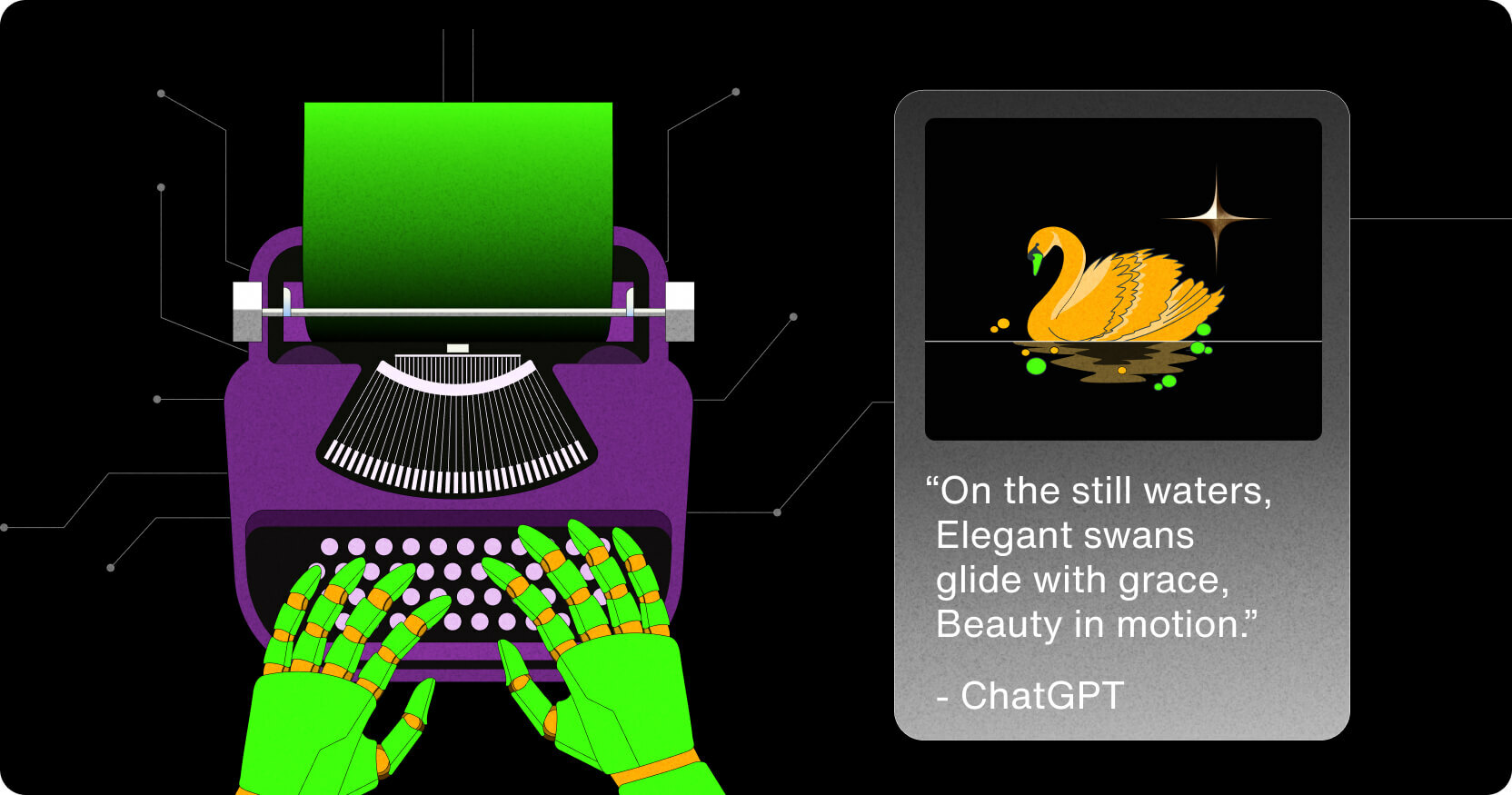Generative AI: What it is and how to use it

It’s not an understatement to say that generative artificial intelligence is a breakthrough technology.
With all this buzz, it’s important to stay informed. Here’s an introduction to generative AI: what it is and how you can utilize it for your business today and in the future.
What is generative AI?
Generative AI refers to a branch of Artificial Intelligence that involves creating models capable of generating new content, such as images, text, or audio, that closely resemble examples from a given dataset. Generative AI models use techniques like deep learning and neural networks to generate original and realistic outputs.

Reimagine customer service with AI agents
How does generative artificial intelligence work?
Generative AI tools combine machine learning models, AI algorithms, and techniques such as generative adversarial networks (GANs) to produce content.
They are trained on massive amounts of data and use generative models such as large language models to create content by predicting the next word, pixel, or music note.
For example, generative AI uses natural language processing (NLP) techniques to convert words and punctuation into coherent sentences and parts of speech, resulting in a clear, readable, and natural-sounding message.
It all begins with a prompt.
What are generative AI prompts, and why do they matter?
Prompts are inputs to the generative AI model that describe what the user wants the AI to create. AI models use prompts as a starting point to produce creative content.
Although many prompts are text descriptions, they can also contain images, videos, music, etc. For example, a simple text-based prompt to ChatGPT could be, “Write a haiku about swans on a pond.”

Conversational prompts unlock the potential of generative AI for business. You can use them to create unique new content and enhance customer experiences and customer service via tools like AI chatbots or AI agents.
Generative AI has almost unlimited potential to help businesses, organizations, and individuals improve how they work and play. This article will take you through some of the current use cases and the pros and cons of AI models.
How is generative AI being used today?
Generative AI technology is evolving rapidly, as are the ways it is used to help people create, research, work, and play. Models can be applied to virtually any aspect of business, and developers are constantly finding new uses for the technology.
Some current uses for AI include customer service, content creation, drug research, marketing, advertising, architecture, engineering, and language translation.
Here are a few examples of how people use AI today:
Text generation
Generative AI systems can create or assist in creating content such as articles, scripts, fiction, and ad copy.
Image and video synthesis
Generative AI models can use text-to-image prompts to create realistic new images, videos, animations, 3D models, and layered graphics for use in TV, movies, video games, and other media.
Marketing and advertising
Businesses can use AI models to process and analyze big data sets and produce relevant and targeted ad copy, campaigns, branding, and messaging. Companies can also use it to launch innovative advertising concepts, like Coca-Cola’s Create Real Magic campaign that lets customers use GTP-4 to create their own Coke artwork.
AI agents and chatbots
AI models are at the core of conversational chatbots and AI concierges. Chatbots respond to customer requests and inquiries in natural language and can help customers resolve their concerns, while AI agents can take action and resolve more complex customer inquiries.
For example, Sendbird’s AI agents can serve as a financial advisor, leveraging customer data like their transaction history, past support conversations, and other information to provide personalized customer service and advice. To learn more, check out our introductory blog on
These are just a few of the countless ways people use generative AI. As the technology evolves, even more use cases will be discovered and developed.

Anywhere, anytime AI customer support
Types of generative AI
Generative AI can be applied to create virtually any type of content. As the technology becomes more accessible to users, innovations are emerging that are tuned to different applications and use cases. Here are a few of the types of artificial intelligence models in use today:
Language generation
Tools like GPT-4 and Jasper assist users in generating written content or auto-generating content from user prompts.
Image generation
Users can use tools like Dall-E 2, Midjourney, and Stable Diffusion to create realistic images and artwork. Picsart's AI image generator is another great option. "
Code generation
Models such as CodeStarter, Codex, and GitHub Copilot facilitate code development.
Voice synthesis
Voice synthesis tools like Descript and Listnr create natural-sounding human voices.
Chatbots
AI chatbots such as ChatGPT and Google Bard use NLP to provide human-like responses to questions and prompts. Unlike decision-tree-based chatbots and legacy AI like Dialoglow generative AI chatbots develop high-quality, conversational, context-aware responses.
What is ChatGPT?
ChatGPT (Chat Generative Pre-trained Transformer) was released in 2022 by OpenAI. The GPT model uses a transformer-based neural network trained to provide relevant, human-like responses. It can interact with users and produces fast, accurate responses. ChatGPT-powered chatbots offer a conversational experience for customer service and use NLP techniques to have natural, engaging conversations with customers. These conversations are more valuable to customers because they are quick, informative, and tailored to their needs. They also strengthen bonds between brands and customers by creating a stronger sense of trust and care.
Pros and cons of generative AI
The rapid growth and evolution of AI models and their use cases have revealed several advantages and disadvantages. Let’s look at some of the potential pros and cons of adopting AI.
The advantages of generative AI
AI models have proven to be powerful business tools and have revolutionized many aspects of modern business. The advantages of generative AI are growing almost as fast as the technology itself. Here are a few core advantages to businesses:
Cost savings
AI models can streamline and automate repetitive manual tasks to save time and resources and reduce errors. In many cases, this can lead to significant cost savings for businesses.
Personalization
Generative AI provides personalized experiences based on user history and preferences. For example, companies can produce curated content for customers, such as music playlists, book recommendations, and more.
Creativity
Creators can use AI to create new and unique content and concepts, leading to new creations and ideas previously thought impossible.
Improved accuracy
AI models can help identify patterns in large data sets, leading to more precise predictions. This can enhance the accuracy of analyses and forecasts and support informed strategic decision-making.

Automate customer service with AI agents
Risks of generative AI
While generative AI technology can help businesses, it's important to remember that some challenges come with it. These challenges could potentially put businesses at risk, and it's important to be aware of them.
Data accuracy and plagiarism
AI models can provide inaccurate data and information and don’t always provide content sources. This makes it difficult to confirm the accuracy of sources and can lead to a lack of trust in AI-generated content.
Bias and discrimination
The training data used to teach the AI could contain biases or misinformation that can result in discriminatory or unethical outcomes, such as false depictions of people or organizations that can cause reputational damage to the business.
Security
AI models can be used for criminal or unethical activities, such as deepfake phishing scams, impersonating individuals for social engineering cyber attacks or gaining unauthorized access, or creating fake news and content to manipulate public opinion. These activities could result in liability or reputational damage to any businesses involved or victimized.
Risk mitigation
Many of the risks associated with generative AI can be mitigated. First, carefully selecting the new data used to train the AI models to avoid toxic or unethical content can reduce the chance of bias or negative outcomes. Businesses can also consider using customized AI models that suit their needs and minimize the risks associated with public AI models. Finally, organizations can keep a human “in the loop” to monitor the AI model’s output.
The key is to be aware. The other way is to provide prompts that frame the AI; for example, not letting run free with every company-related topic.
Generative AI models are still a relatively new development, so we haven't seen their long-term effects yet. However, as these models become more advanced and powerful, they will continue to push the limits of what’s possible. That means the benefits and risks of AI models will also continue to grow and evolve as new use cases, and capabilities are discovered. By staying proactive, businesses can position themselves to take advantage of future benefits while being aware of risks before they happen.
Introducing Sendbird ChatGPT-powered chatbots
Sendbird ChatGPT-powered chatbots enable businesses to empower their AI chatbot capabilities and enhance customer experiences. GPT AI technology raises the bar for chatbot interaction, allowing businesses to improve customer engagement, satisfaction, and loyalty while driving revenue growth. The conversational AI technology is trained on first-party data, ensuring that businesses can provide top-notch support to their customers.
Try our demo to see how our ChatGPT-powered chatbot can empower your customer experience!










